Knowde Enhanced TDS
Identification & Functionality
- Chemical Family
- Agrochemical Functions
- EC No.
- ELINCS 435-740-7)
- Technologies
Features & Benefits
- Agrochemicals Features
- Advantages of UREAstabil Fertilizer
• Saturation of the root zone by NH4 + – creation of nitrogen supply and elimination of subsequent drought impacts
• A wider application period whilst maintaining the mobility of nitrogen
• Minimal toxicity to germinating plants during precision placement of the fertilizer
• Nitrogen utilization even at low soil temperatures
The basic advantage of UREAstabil fertilizer is a combination of rapidly soluble,
well absorbable nitrogen with a urease inhibitor. This ensures a reduction of
nitrogen loss in the form of ammonia volatization into the atmosphere during
surface applications. Above all, however, it restrains the sorption and fixation of
NH4
+ in the surface soil layer, which slows the effect of this nitrogen form down.
The combination of amidic nitrogen and the urease inhibitor in the product enables early applications and higher doses, when the most suitable conditions for the transport of a non-polar molecule directly to plant roots supervene. At low temperatures of soil the NH4 + form is the best accepted form of nitrogen. A positive effect of the intake of macronutrients and micronutrients from the soil has been recorded when fertilizing with the amidic nitrogen. A big advantage of UREAstabil fertilizer is also the possibility of applying it to seeds without any adverse effects on germination and root growth. This makes UREAstabil a fertilizer with a broad application in agriculture.
Nitrogen losses due to ammonia volatization when applying fertilizers on the soil surface (temperature at 10°C)
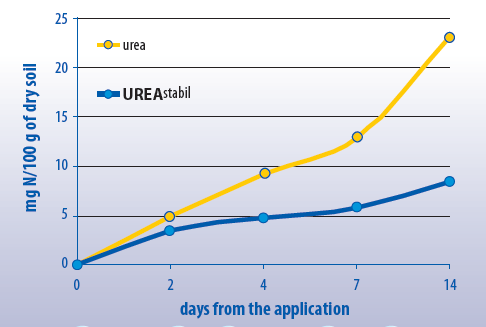
- The Importance of Urease Inhibitor NBPT
• Improvement of nitrogen penetration to plant roots by restraining the sorption and fixation of NH4 +
• Reduction of losses due to ammonia volatization into the atmosphere during surface applications- Advantages of UREAstabil Fertilizer in Comparison with AN (ammonium nitrate)
• A higher content of nitrogen (46 %)
• A very good solubility and transport to plant roots even at lower precipitation
• Utilization of nitrogen by plants even at lower soil temperatures
(important during regenerative fertilization)
• Nitrogen uptake by roots in 3 different forms (amidic, ammonium and after nitrification also in a nitrate form)
• No adverse effects on plant germination when applied together seeds during sowing procedure
• A longer-term effect – a possibility of increased doses and therefore reducing the number of applications
The influence of UREAstabil fertilizer on dry mass yield of spring wheat plants (Ruzyně Experimental Institute 2004 - 2005)
The following graph shows how spring wheat plants react in containers when using
different types of fertilizers, which were applied to the soil surface at the stage of 3rd leaf (end of tillering). The listed results characterize the level of dry mass creation until the stage of stem elongation. During a long-term absence of precipitation UREAstabil had a more important influence on the dry mass creation in comparison with an untreated urea.

Applications & Uses
- Markets
- Applications
- Applicable Crop
- Application Technique
- Optimal Time of Use
Up to 18 months if stored in the original closed packaging under recommended storage conditions.
- Range and Condition of Usage
UREAstabil is urea ammended with the urease inhibitor, NBPT, which stabiliz e ur ea, slows down its decomposition and limits nitrogen los ses by ammonia leaks after application on th e soil surface. This fertilizer is designed for basi c fertilization before se eding and also for application in vegetation period of plants. Incorporation of the fertilizer into the soil by cultivation is recomm ended after application. UREAs tabil is also suitable for subsurface application when establishing agricultural plant growth. For regeneration fertilizing made at the beginning of spring vegetation on t he wintercorn growth on soils with low sorption capacity there is recommended to use a maximu m of 200 kg / ha of UREA Stabil . It is not recommended to use UREAs tabil for fertilizing strong winter freeze injured plants of oilseed rape. UREAs tabil is also su ited for preparation various foliar feeding solutions.
- Recommended Dosage
Recommended dosage kg/ha cereals 150- 400 oilseed rape 150-450 potatoes, sugar beet, corn 150-400 grassland 150-450 It is more suitable to specify application rates by taking into account a nor mal need of the individual crop plant, with respect of preceding crop and with respect of current fertilizing with homestead fertilizers. Also usage of objective diagnostic procedures (i.e. plant or soil analysis) is recommended.
- Possible Applications
• Application to seeds and during the precision placement of fertilizer
• Autumn application to winter rape
• Regenerative fertilization of winter crops (rape, cereals)
• Production additional fertilization of cereals and rape
• Basic fertilization and additional fertilization of spring crops
• Last seasonal fertilization of wheat
The fertilizer is suitable for the fertilization of spring as well as winter crops and is used for surface broadcast application and for subsurface band application (e.g. precision placement of fertilizer) as well. The regenerative fertilization of winter cereals and rape has proved itself competent particularly at a slow onset of spring with lower temperatures. The best results are obtained when the application of UREAstabil fertilizer is followed by cool and humid weather with precipitation of min. 5 mm within 14 days after the application. When fertilizing irregular vegetation at air temperatures above 20 °C, wind and a long-lasting drought it is necessary to pay close attention to a higher risk of ammonia volatization. This applies for example to last seasonal fertilization of wheat, surface application of corn etc.- Dosage
When determining the dosage of UREAstabil we decide upon:
• The overall needs of nitrogen considering the planned yield
• Nmin reserves in the soil
• Characteristics of the weather during vegetation
• Number of planned nitrogen doses
• Crop growth structure
Properties
- Chemical Properties
| Value | Units | Test Method / Conditions | |
| Total Nitrogen | 46.0 | %(w/w) | - |
| N-(N Butyl) Thiophosphoric Triamide Urease inhibitor | min. 420 | mg/kg | - |
| Biuret | max. 1,2 | %(w/w) | - |
| Particles From 2,5 Mm To 5 Mm | min. 85 | %(w/w) | - |
| Particles Under 2 Mm | max. 3,0 | %(w/w) | - |
Regulatory & Compliance
- Regulations
Product UREA stabil meets requirements of the R egulation (ES) No 2003/2003 of October 13, 2003 as amended. Type of fertilizer: A.1.9 with urease inhibitor F2 (Annex I).
Technical Details & Test Data
- Risk Particles Content in Fertiliser
Risk particles content in fertilizer does not exceed limits set by decree No. 474/2000Sb
(Cd < 1mg/kg; Pb < 10mg/kg; Hg < 1mg/kg; As < 10mg/kg; Cr < 50mg/kg)- Technical Details
Winter Wheat
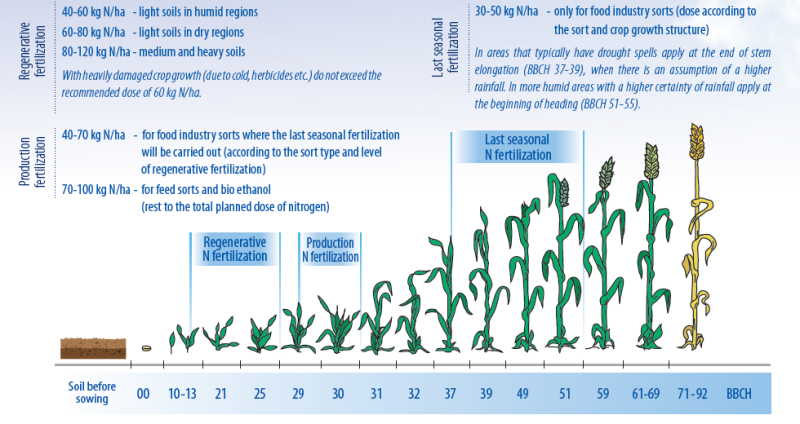
Corn
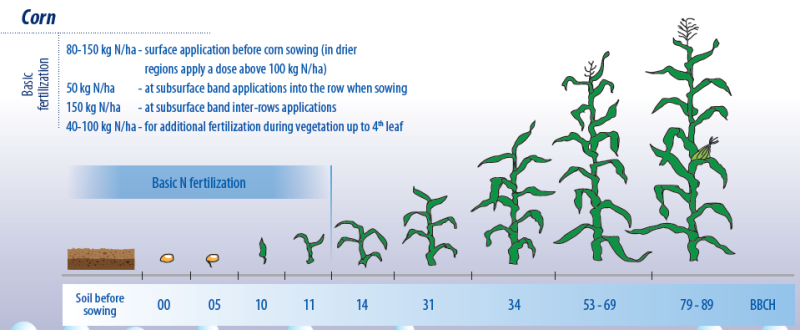
Spring Barley

Poppy Seed
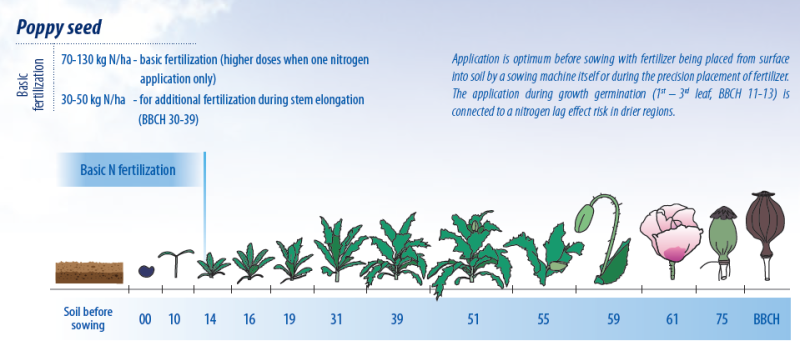
Winter Rape
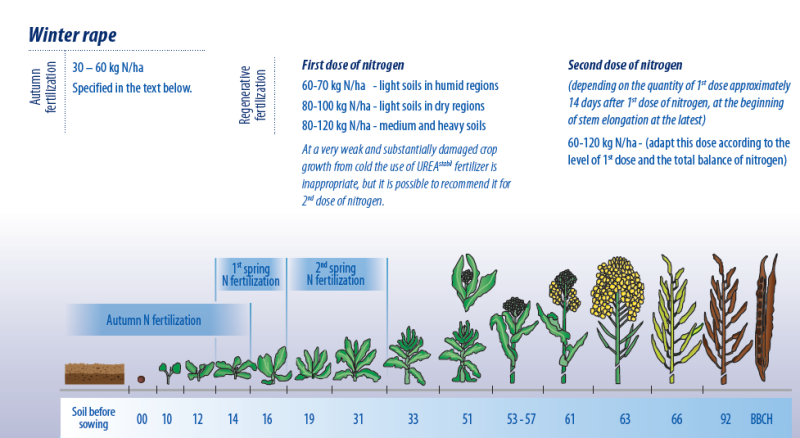
Winter Rape - Autumn Nitrogen Fertilization
Technology Basis
• Movement of a part of applied nitrogen from the spring season to autumn vegetation
• The total dose of nitrogen does not increase, only the distribution is changed
Aim of Fertilization
• For plants to have a strong entry into winter
• A safe start of spring vegetation even under adverse conditions for regenerative fertilization
• Straw decomposition assurance
• Promoting the creation of branch bases and flowers already in the autumn
Effect Principle
• Assures the supply of acceptable ammonium nitrogen in the root zone is already in place by the autumn
• Faster and more intensive transfer of assimilates from leaves to the root => increase in the intensity of root growth and branching
• The supply of NO3 - in leaves is not increased (nitrogen is already incorporated into amino acids in the root) => a lower risk of frost damage
• Nitrogen in plant´s biomass is the primary source for the plant in the spring
• Ammonium nitrogen in the root zone is the fastest absorbable form for the restoration of root activity (NH4 + intake is 2 - 3 times more intensive from 1 - 2 °C than that of NO -)
Other Advantages of Technology
• Decrease in the necessity of a very early regenerative dose nitrogen – enlargement of the application period (for example during waterlogging)
• Maximum usage of early spring moisture
• Only 2 spring doses of nitrogen
Terms and Doses
• Crucial factors for decision making:
- Soil tillage technology – depth and method
- Distribution and decomposition of straw in soil
- Plant strength and coloring, depth of root branching
- Balance and requirements for the release of nitrogen in the autumn and spring
• Dose of 30 – 60 kg N/ha
• Application from the middle of September to the beginning of fertilization ban
• It is necessary to carry all the applications out according to legislation in force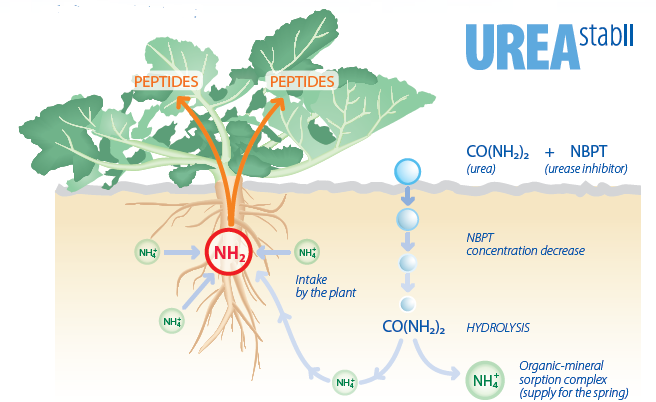
After the dissolution of a UREAstabil granule, the concentration of the inhibitor (NBPT) decreases during its penetration into the root zone and because of the urease activity, the hydrolysis of urea takes place: CO(NH2)2 to NH4 +. A part of NH4 + ions is already absorbed by the plant by the autumn and it is converted into amino acids in the roots. They are transported to the leaves without causing an excessive intake of water and so decreasing the frost resistance. The remaining part of the NH4 + ions binds to the sorption complex creating a supply of nitrogen for the spring.
Safety & Health
- Safety and Health
Instruction for safety and health protection during work:
Keep away from from chi ldren (S2). Do not eat, drink and smoke during use (S20/21). Do not inhale dust (S22). If eyes are affected rinse thoroughly with water and search for medical help (S26).
Packaging & Availability
- Packaging Type
- Packaging
Package Sizes Available: 50 kg PE bags, 50 0 and 1000 kg big bag
Storage & Handling
- Storage Conditions
Store away from children (S2), separately from food, drink and animal feeding stuffs (S13). Store in original closed packages in a dry area protected by a roof, wi th temperatures under 35 ºC. Long term storag e in temperatures higher than 35 ºC and /or with open air conditions results in lowering the efficiency of the urease inhibitor. If stored longer than 18 months, fertilizer can be used but without the full effec t of the urease inhibitor.

